





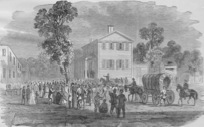
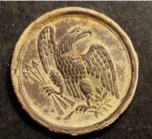 Civil War Medal Breast Plate dug near Peachtree Creek Battle site
Civil War Medal Breast Plate dug near Peachtree Creek Battle siteCitizens getting passes to go N. and S. in consequence of General Sherman’s order for the departure of all citizens
Frustrated at his inability to pound and starve Atlanta into submission, General Sherman on August 25 sent the XX Corps, now commanded by Major General Henry D. Slocum, back to the Chattahoochee River at Bolton to protect the railroad and Turner’s and Pace’s Ferry crossings. Major General Joseph Hooker had been incensed by Sherman’s appointment of Oliver O. Howard, whom Hooker outranked, to succeed the slain General McPherson as commander of the Army of the Tennessee. Hooker, with indignation asked to be relieved of command of the XX Corps, a request which Sherman gladly agreed to, naming Slocum to succeed him.
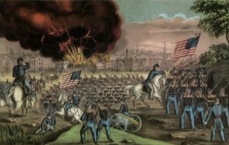
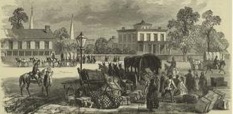
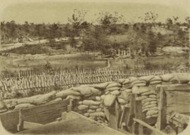
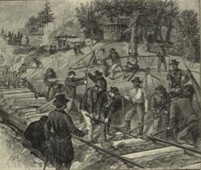
The Capture of Atlanta Ga.
Sept. 2, 1864
Citizens of Atlanta leaving the city in
compliance with Sherman’s order
Jefferson Cain, an employee of the Western and Atlantic Railroad, was Engineer of the General. At 4:15AM on April 12, 1862, Cain pushed the throttle forward and drove the train out of Atlanta, Georgia for Chattanooga as a cool spring rain fell on the city. In the spring of 1862, the peaceful town of Big Shanty (now Kennesaw) Georgia was paid not-so-peaceful visit by Union spies that were led by James Andrews, who brought with him plans to disrupt Confederate supply lines. Andrews and his men boarded the train in Marietta, Georgia. They had spent the night before at the Fletcher House (now the Kennesaw House.) Twenty boarded the train and two were left behind. The next stop was the Lacy Hotel in Big Shanty (now Kennesaw) for a 20 minute breakfast break where the General was stolen in view of Camp McDonald that was home to many enlisted men and officers. There was no telegraph there which was one reason Andrews chose this site. James Andrews, a Kentuckian, had made a name for himself by smuggling the much needed quinine through Union lines for Confederate soldiers and Southern civilians. There were with him three experienced engineers, William Knight, Wilson Brown and John Wilson. When asked where they were from their reply was, "I am from Fleming County, Kentucky." They also said they were going to join the Confederate army. The official plan to steal the General was approved by Union General Ormsby Michael. The plan was to take the locomotive north on the Western and Atlantic Railroad and destroy tracks, bridges and tunnels along the way. General Michael agreed that he would take Huntsville on April 11, 1862, and then would wait for Andrews before moving into Chattanooga, Tennessee. "Someone...has stolen our train," William Fuller, Conductor of the General said in amazement as the train was stolen and was pulling away from the train depot. Men of the Atlantic and Western Railroad immediately began the chase with Engineer Jefferson Cain, William Fuller and machine foreman Anthony Murphy close behind. With no telegraph at Big Shanty, the men ran north for two miles to Moon Station and procured a platform handcar, then went on until they found the locomotive "Yonah." The second train used was "the William R. Smith." The last locomotive Fuller used was the famous "Texas" that was heading south. The Texas is now housed at the Cyclorama at Grant Park in Atlanta, Georgia. With no time to spare, the Texas was run in reverse through the entire chase.
Rebel lines -- Atlanta Ga.
James Andrews and his Raiders were slowed down by South Bound trains that had to pass before they could continue. With the telegraph out of service, Fuller was fortunate to catch telegraph operator Edward Henderson. Fuller gave the young Henderson a hand up on the train, still in motion, to take a message that he would send to General Ledbetter from Dalton, Georgia.
Andrews and his raiders failed to destroy the bridges over Georgia's
Chickamauga Creek, Etowah River at Tunnel Hill. They also failed to slow down their pursuers by setting the cars of the General on fire and sending them back down the railroad tracks. The end came when they ran out of wood and lost power about 18 miles South of Chattanooga.
Sherman’s men destroying a railroad
It took about two weeks for the Confederates to
capture the Union spies. Some of them made it as far as Bridgeport, Alabama. All 20 of Andrews Raiders were captured. James Andrews and 6 of his men were hung in Atlanta, eight escaped and others were paroled.
The United States Congress created the Medal of
Honor in 1862 and it was awarded to some of the
raiders. James Andrews was not eligible because he was not a part of the military service.
The South's William Fuller, who is buried in Atlanta's Oakland Cemetery, was recognized by the Confederate government, Georgia's Governor Joseph Brown and Georgia State Legislature for his act of heroism.

“ Bring the good old bugle boys, We’ll sing another song.
Sing it as we used to sing it, fifty thousand strong,
As we are marching through Georgia.”
Battle at Peachtree Creek
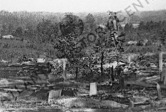
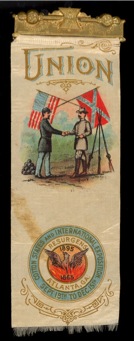
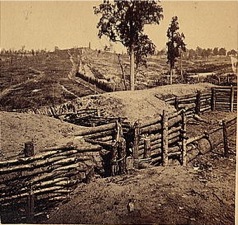
Rebel lines NW of the city between
W&A RR and Peachtree Street
Nov. 1864
 SECTION OF THE CYCLORAMA OF THE
SECTION OF THE CYCLORAMA OF THE BATTLE OF ATLANTA




The Battle of Peachtree
Creek was fought on
July 20, 1864, as part of the
Atlanta Campaign in the
Civil War. It was the first major attack on Atlanta by Maj. William T. Sherman’s, Union Army of the Cumberland, commanded by Maj. Gen. George Henry Thomas, and was the first battle commanded
by Lt. Gen. John B. Hood, who had just relieved Gen. Joseph E. Johnston, of the Army of Tennessee.

2007 was the 51st anniversary of Walt Disney Picture’s classic
“ The Great Locomotive Chase” starring
Fess Parker and Jeffrey Hunter.
2007 is also the 145th anniversary of the Great Locomotive Chase.
America’s most famous locomotive
“ The General” is now home in Kennesaw, at the
 ADVISE TO SOLDIERS - 1862
ADVISE TO SOLDIERS - 1862[American Civil War]
A correspondent writes to the Middlebury Register, to give to the inexperienced soldiers some hints for the preservation of health, from what he has learned in the field. After warning the new recruit that the enthusiasm of the first week will soon tone down to stanch realities, which he must meet and face as a man - that he cannot live as carelessly about his health, as he can at home, where warm rooms and comfortable beds and well cooked meals are at his service from day to day, and that he must act the physician for himself, to a great degree, and be watchful against any predisposition to disease, he proceeds to give some special directions as follows:
They consist of a program of articles to be taken by the recruit when he goes into camp, or to be sent to him by his friends, when he shall have reached a point where he can be addressed.
Let him have with him two pairs of socks, two firm woolen shirts, a large crash towel, a piece of Castile soap, to be used as often as possible in bathing the entire body; a woolen cap, sometimes called a smoking cap; two large old fashioned silk pocket handkerchiefs, which may be used to hang from the neck, as a protection against a blazing sun, or as a veil to cover the face when sleeping out nights, amid miasmas and creeping vermin, or as a bandage for wounds. He should also have constantly with him a supply of Cayenne pepper, such as is obtained from the drug stores under the name of “capsicum.”
The benefits arising from the use of this latter article ( Cayenne pepper ) are incalculable. A single pinch in a glass of flat warmish water will nullify the effects and the uncomfortable sensation from having drunk too much water during the day; will help the sentinel keep awake at his post at night, by warming and invigorating the whole system. A good pinch eaten at each meal, or when a cup of tea or coffee is drunk, will aid digestion, assist in preventing acidity of stomach, and is besides a great antagonist of the diarrhea, dysentery, flux, and “ looseness,” which are the great scourges of the army. A level teaspoonful of capsicum, taken daily in eating or drinking, or both, or two fingers full taken two or three times a day, will do more toward warding off the fever and ague than ten times the cost in rum and quinine. There should always be carried in the knapsack also a large piece of gutta percha cloth, to spread upon the ground at night for the soldier to spread his blanket on when he goes to bed. To these suggestions may be added the injunctions to eat, as far as possible, regularly, to shun sutlers’ tents, with their detestable pies and cakes, and their poisonous preserved meats, as one would shun a contact with the leprosy; to maintain, is short, a perfect system of living, just as far as duty in camp will allow.
If my friend who may read this, and who is going to buckle on his armor for the cause of his country, will treasure the hints I have thrown out, and act upon them, he will add a hundred per cent to the probabilities of his returning to his father’s house, that knew such keen anguish and bitter mourning when he was called to leave it. Once more, my soldier friend, before you leave your home, supply yourself with envelopes and writing paper, and with a good substantial lead pencil, upon the envelopes have postage stamps placed, and have them directed in a strong, plain hand to the address of those you will want to write to when far away, your father, your loving and ever watchful mother, or your sister, and then, when you stop anywhere, for a day or such a matter, write something home, if it is not more than six lines, and tell your anxious friends how you are. And to your parents too and relations of the soldiers, I must say, write often to him. Write long letters. Give all the news you can think of. Let every line be full of love, of kind, affectionate interest and encouragement, and you cannot tell how much sunshine you will put into his heart, and how much better soldier and man he will become for your thoughtfulness of him. I speak of all these things “ whereof I have seen.”

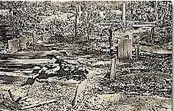
Wooden headstones along
the line of battle south of Peachtree Creek
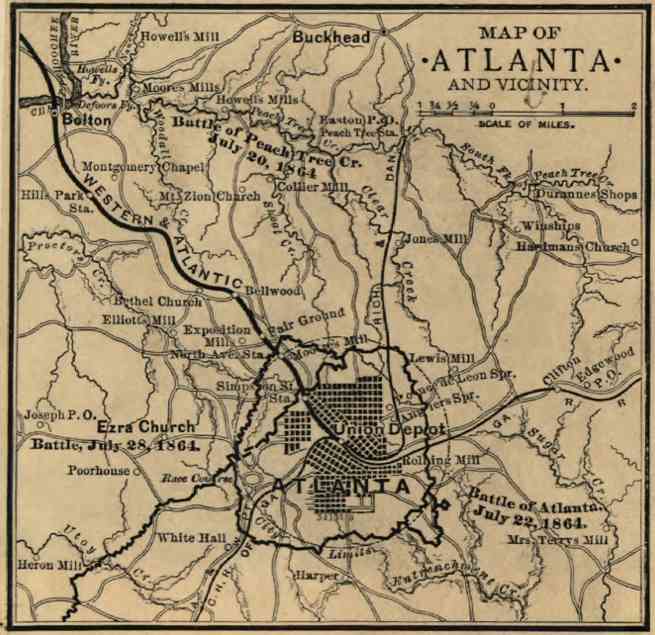
Map of Atlanta and vicinity 1887

Fort Walker, Grant Park 1909
Battle at Kennesaw Mountain
by Kutz & Allison 1891
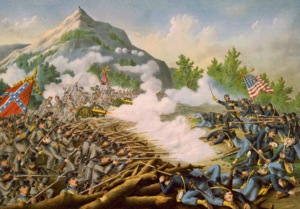
Battle of Kennesaw Mountain Red Confederate Blue Union
Confederate troops dragging guns up Kennesaw Mountain, in defense of Atlanta, Georgia.


The name Kennesaw is derived from the Cherokee Indian "Gah-nee-sah" meaning cemetery or burial ground.
Kennesaw Mountain Battlefield is a 2,923 acre National Battlefield that preserves a Civil War battleground of the Atlanta Campaign. The battle was fought here from June 19, 1864 until July 2, 1864. Sherman's army consisted of 100,000 men, 254 guns and 35,000 horses. Johnston's army had 63,000 men and 187 guns. Over 67,000 soldiers were killed, wounded and captured during the Campaign.

